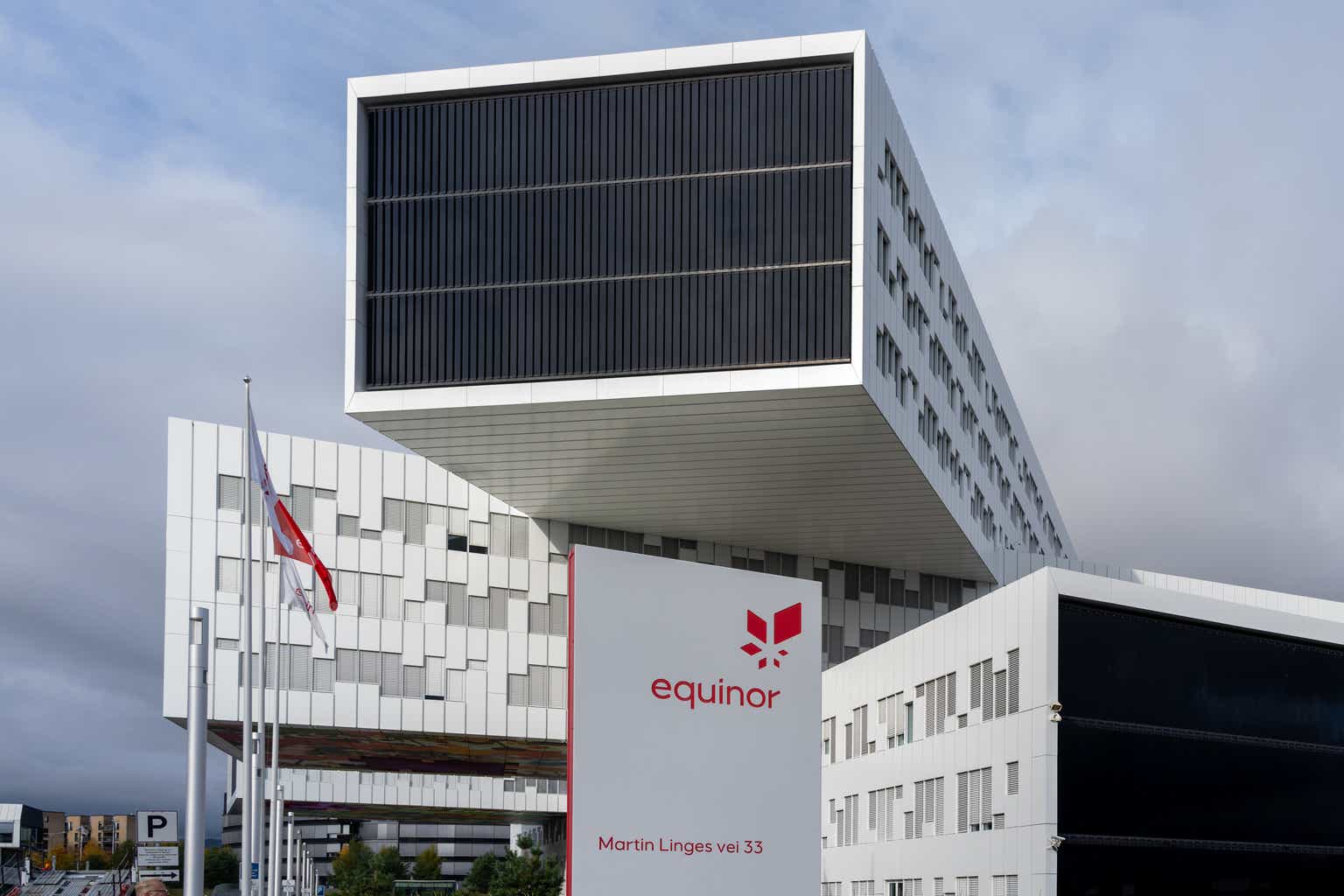Introduction
As an investor focusing on dividend growth stocks, I always look for new opportunities to invest in income-producing assets, mainly equities. I add to my existing positions when I find them attractive. I also use market volatility to my advantage by starting new positions to diversify my holdings and increase my dividend income for less capital.
The energy sector is interesting, Equinor in particular. I covered EOG Resources (EOG) in my last article, and this time I return to Equinor (NYSE:EQNR) following its Q1 results published on Thursday. Equinor is controlled by the Norwegian government, which holds 67% of the shares. Therefore, the company is conservatively run and is poised to succeed even during recessions or when demand is lower.
I will analyze Equinor using my methodology for analyzing dividend growth stocks. I am using the same method to make it easier to compare researched companies. I will examine the company’s fundamentals, valuation, growth opportunities, and risks. I will then try to determine if it’s a good investment.
Seeking Alpha’s company overview shows that:
Equinor ASA, an energy company, engages in the exploration, production, transportation, refining, and marketing of petroleum and other forms of energy in Norway and internationally. It operates through Exploration & Production Norway, Exploration & Production International, Exploration & Production USA, Marketing, Midstream & Processing, and Renewables. The company also transports, processes, manufactures, markets, and trades in oil and gas commodities, such as crude and condensate products, gas liquids, natural gas, and liquefied natural gas. The company was formerly Statoil ASA and changed its name to Equinor ASA in May 2018.
Fundamentals
Revenues have increased by almost 35% over the last decade. The increase in sales is attributed to higher energy prices and higher production by Equinor as it attempts to support the European demand for oil and gas following the war in Ukraine. The gas price has skyrocketed in Europe, which is $19 per MMBtu (Metric Million British Thermal Unit) compared to the $3.2 MMBtu Americans pay. Still, the company has missed the sales estimates by $500 million. In the future, as energy prices keep declining compared to Q1 2022, analysts’ consensus, as seen on Seeking Alpha, sees roughly a 10% annual decline in sales in the coming three years.
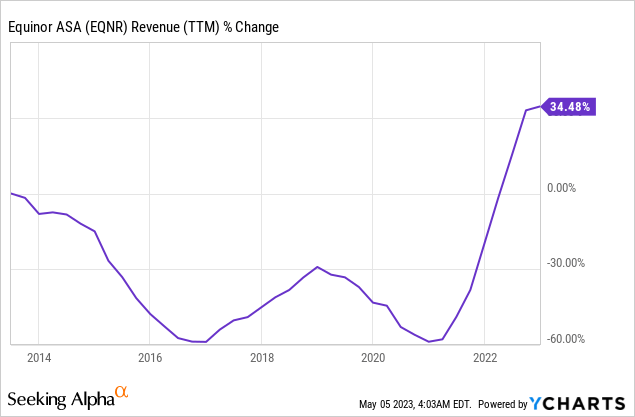
The EPS (earnings per share) has increased much faster. The increase in demand for natural gas has sent the price upward. The cost of producing every MMBtu hasn’t changed significantly, and therefore the margins have increased considerably, and the EPS has increased much faster than the sales. As EPS has more than quadrupled in a decade, Equinor has produced significant cash. However, the company can’t rely on such margins as Europe is working on lowering its dependence on natural gas. Therefore, analysts, as seen on Seeking Alpha, expect that the 2025 EPS will be more than 30% lower than the 2023 EPS.
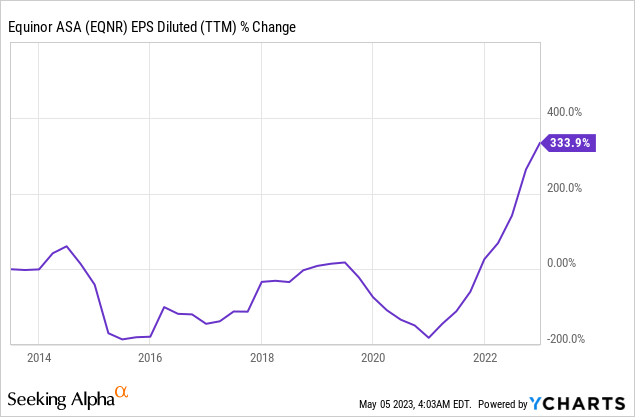
The dividend policy of Equinor is different from that of major American energy companies. The company is more conservatively run and, therefore, will not prioritize dividends when they cannot be covered by cash flow. Thus, the payment is more erratic, the payout is low, and the current yield is roughly 2%. On the other hand, the company pays special dividends to supplement the conservative dividend. Investors who seek an ever-growing, extremely reliable dividend will not find it with Equinor.
For the first quarter, the Board approved a regular cash dividend of $0.30 per share, which was a 50% step up from last quarter. In addition, an extraordinary cash dividend of $0.60 per share makes the total cash dividend $0.90.
(Torgrim Reitan – EVP & CFO, Q1 conference call)

In addition to dividends, companies return capital to shareholders via buybacks. Buybacks allow companies to accelerate EPS growth by lowering the number of shares outstanding. Equinor has not been very active in the buyback realm, and over the last decade, the number of shares has decreased by 2.5%. Additional buybacks when the share price is low will be an effective way to improve the growth of the EPS, even when energy prices are sluggish. The company announced in its Q1 report that it continues to execute a $6B buyback plan.
We continue to execute a $6 billion share buyback program for this year.
(Torgrim Reitan – EVP & CFO, Q1 conference call)
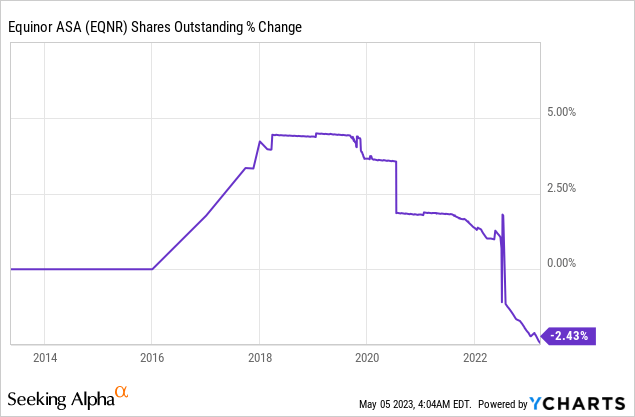
Valuation
The P/E (price to earnings) ratio of Equinor stands at 5.7 when using the 2023 forecasted EPS. The current valuation is very low, and it will stay soft even after the EPS keeps declining as the energy prices will stabilize. The P/E ratio, when using the 2025 EPS forecast, stands at 8.38. Paying eight times earnings for a conservatively cash-flowing company with a history of growing sales and EPS makes a lot of sense.
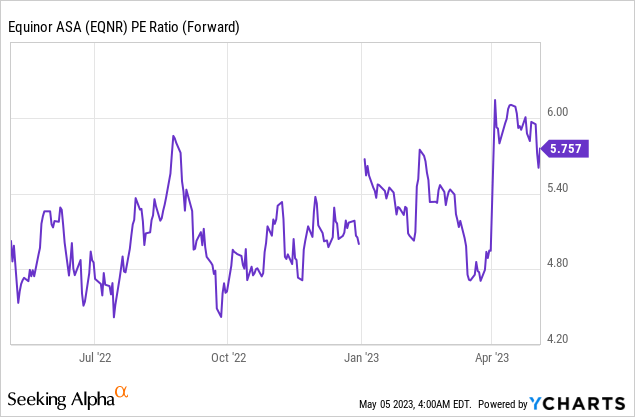
The graph below from Fastgraphs emphasizes that the shares of Equinor are valued attractively. The average P/E ratio of the company over the last two decades stands at 10.8, and even following the EPS decline, the P/E ratio will be 8.3, significantly lower than the historical valuation. The ability to buy Equinor for a discount, when the company has historically grown by 5% annually, makes it attractively valued.
Fastgraphs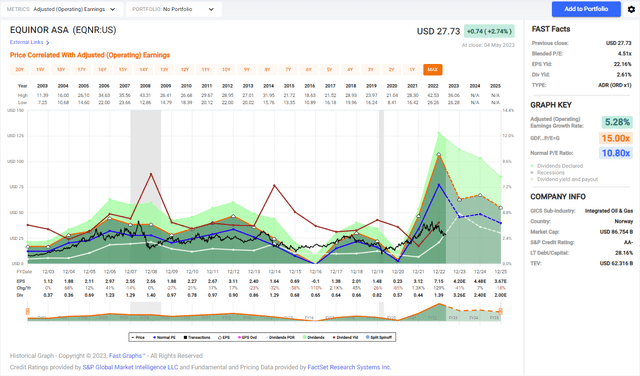
Opportunities
Renewables are the first long-term opportunity for the company. The company invests heavily in wind power energy production, and it is one of the owners of Dogger Bank Wind Farm, the largest in the world. Moreover, the company also invests in the European infrastructure for hydrogen and in carbon capture needed to turn blue hydrogen into a sustainable and low-emission energy source.
Our renewable business delivered $29 million from assets in operation. And as we continue to build this business, the high level of project activity and business development will result in negative adjusted earnings. And we expect results at this level for the next quarters before it will improve following the start-up of the Dogger Bank projects.
(Torgrim Reitan – EVP & CFO, Q1 conference call)
Equinor Capital Markets Update Feb 2023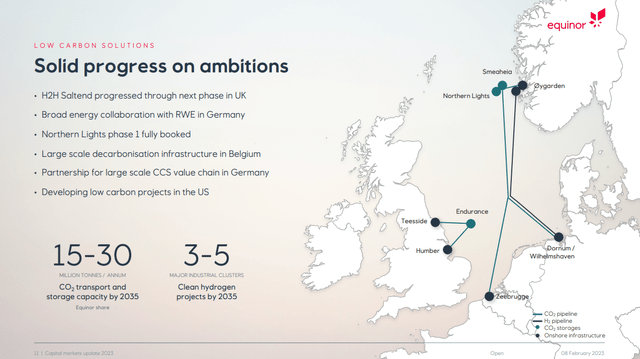
The company has a high demand for oil and gas from Europe in the medium term. As long as the war between Russia and Ukraine rages, there will be no demand for Russian gas from Europe. It allows Equinor to increase the price of natural gas closer to the cost of LNG, despite transferring it through pipelines. Therefore, the margins will stay extremely high as long as there is no other pipeline alternative and the demand is high.
In the longer term, which is your question, we see that the marginal price for gas in Europe will be much closer linked to international trading of LNG cargoes, whether Asian or European prices for that LNG. So the market dynamic is changing from Russian gas being the marginal price center for gas to international energy being that. So clearly, price signals from Asia will be very important in future gas prices in Europe.
(Torgrim Reitan – EVP & CFO, Q1 conference call)
Another short-term opportunity is the company’s cash position. If we see a decline in energy prices due to a possible recession, Equinor can leverage its cash to buy assets for cheap. The company has a negative net debt of more than $10B and can use it to acquire assets without putting any risk on its balance sheet. Acquiring assets without worrying about interest expenses puts Equinor in a strong position.
So our solid balance sheet is the basis for good risk management, and our strong cash flow makes us resilient. Our net debt is further reduced to negative 52%, driven by the strong cash flow shown on this slide and, in addition, lower working capital which has been reduced by around $5 billion, and also lower collaterals due to lower gas prices.
(Torgrim Reitan – EVP & CFO, Q1 conference call)
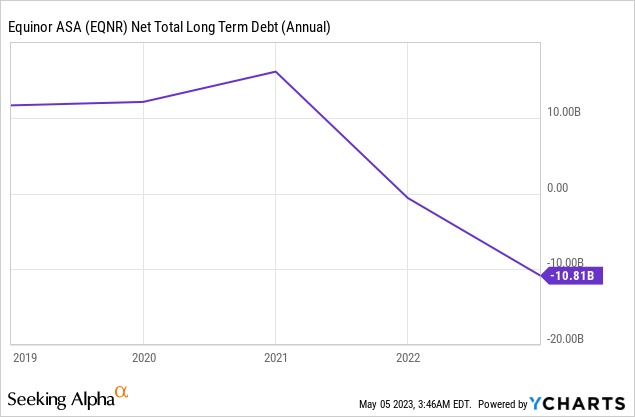
Risks
While there are some decent growth opportunities, there are several risks. The first risk is unique to Equinor when compared to its major peers. This is the risk of government ownership. The Norwegian government owns 67% of the shares, so that the company will execute according to its primary shareholder needs. The company is likely to be conservative and focus on developing the Norwegian economy even if other areas may be more attractive.
In addition, the company is also dealing with industry-wide risks. The first one is the short-term risk of a recession. A recession may lower the oil price, hurting the company’s EPS. The current EPS forecast already prices lower oil prices, yet a further decline will require additional downward revisions, likely to harm the share price. Therefore, the company is expected to be volatile as the world economy seeks direction.
The last risk is the long-term risk of declining demand for fossil fuels. While natural gas can be used to produce blue hydrogen, the oil demand is forecasted to stagnate. Even under the most optimistic scenario, we can expect less than a 10% increase in demand until 2030. Lower demand may hurt the prices in the long-term as energy companies continue to invest billions in exploration, including Equinor, with a Capex of more than $10B a year.
IEA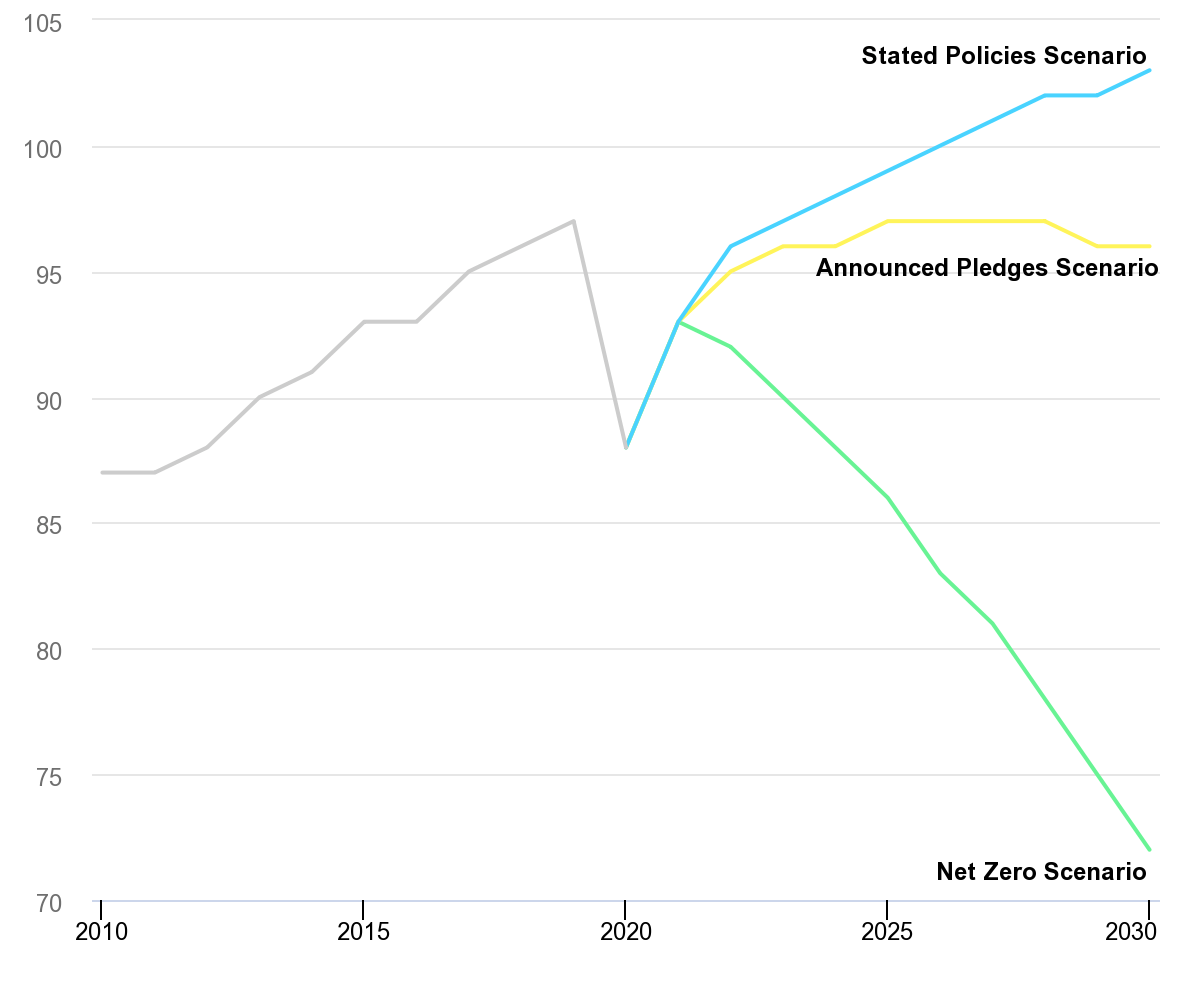
Conclusions
To conclude, Equinor is a decent company. The company has solid fundamentals and an attractive valuation. The company is wise to invest in renewables and greener solutions for energy as the world is going this way. Moreover, there are risks, yet they are limited as the company invests in the future and is run conservatively.
However, the company is still an oil and gas company. Right now, there is a high level of uncertainty. Demand for oil and gas in the short term as we fear a recession, demand in the medium term due to the war in Ukraine, and in the long term due to the global energy transition. Since Equinor has no progressive dividend policy, investors will have to deal with the volatility without having some stability in the form of dividends. Therefore, I believe that the shares are a HOLD as we seek more certainty.
Read the full article here


